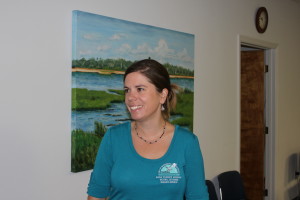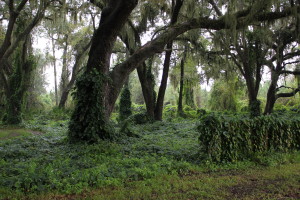Marineland, FL — Just in time for Halloween, experts warn that invasive plants are taking over Florida. They are reportedly spreading through the state like a zombie apocalypse, sucking up resources, melding with the natives, and killing off any plant or animal in their way. Fast breeders, they’re almost impossible to kill. Invasives have crept onto 1.7 million acres of Florida’s public lands and waterways, costing the state $100 million per year to beat them back. The state ranks second in the nation in ecological damage caused by invasive plants, second only to Hawaii.
That’s why Coastal Training Specialist Lia Sansom gave a presentation to the public Tuesday, October 15, 2013, at Guana Tolomato Matanzas National Estuarine Research Reserve (GTM) on Florida’s northeast coast. The state funds GTM and other groups to help get the word out to the public and local officials about the dangers of invasive plants. While there are laws that prohibit the sale and planting of “noxious weeds,” enforcement is expensive and labor-intensive. Florida’s “hospitable” climate, coupled with the fact that three-fourths of imported plants come in through Florida, causes invasive species to be “more of a crisis here than anywhere else in the continental United States,” according to The Nature Conservancy. To be classified an “invasive” means a plant has become “a problem in its location by impacting human health, the economy, or the environment,” said Sansom.

Just how dangerous can a plant really be? The Florida Exotic Pest Plant Council’s website says aquatic invasives can choke waterways – impeding navigation, causing floods, disrupting recreation, reducing water quality, and creating breeding grounds for mosquitos. (And if you wonder what’s so bad about swatting a few mosquitoes, remember that the mosquito-borne West Nile virus killed 69 Floridians in 2012, up from two in 2006.) Land-based invasives also overtake all other vegetation around them, killing off habitat. Invasive vines that have climbed a tree provide a path for fire to spread in habitats that might otherwise be fire resistant.
Causing floods, spreading fire, breeding killer mosquitoes, and killing everything in sight – who are these bad boys? The worst two on Samson’s list are air potato vine and Brazilian Pepper-tree. It’s believed that Brazilian Pepper, a small tree with dark green leaves and red berries, was brought in as an ornamental on both coasts of Florida, one species being drought-tolerant and the other cold-tolerant. Both escaped their residential yards, met in the middle of the state and hybridized, forming a new species that is almost indestructible in the current climate. Matt Welsh, a Monitoring Program Technician at GTM, said Brazilian Pepper “alters the hydrology of an area, toxifies the soil, and forms a monoculture.” In other words, it “sucks up all the water and kills everything around it. We had one get started on a (sand) dune and it took out every dune plant. There was nothing else left.” Once vegetation is gone, animal species in the area are affected, too. The United States Fish and Wildlife Service believes 42% of the nation’s endangered species have declined as a result of invasive plants.
Air potato vine is believed to have been brought in by African slaves, either as a food source or an ornamental. It’s a small, round potato that is often moved from place to place by squirrels. It lies of the surface of the ground, sprouting a vine that can grow 70 feet in length and up to 8 inches a day, covering everything in sight (see photo). It also shoots roots deep underground, making it impossible to kill until it dies back during winter. To eradicate it, bulbs must be picked up by hand and either burned or frozen, recommends the University of Florida Extension Service.

Two of the attendees of Tuesday’s presentation are worried about invasives in their communities. Walt came from a large subdivision in Palm Coast, about 45 minutes south of GTM, to see what could be done about Brazilian Pepper in his neighborhood. “I can help you with that,” said Ann, who is part of a Jacksonville-based volunteer group called Pepper Busters. Even though they are an hour north of Palm Coast, she said the group “travels all over the area” to take out Brazilian Pepper infestations. “I just want all this,” she gestured with her arm to the surrounding dunes, palms, and pines, “to stay like it is.”


Leave a Reply